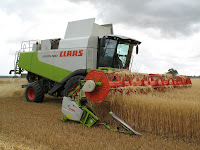Yesterday I spent the day in Norfolk looking at sheep, crops, cattle and turkeys. All integrated systems yet all very different business structures.

These cattle are owned by LF Papworth Ltd. Cousins Tim and Kit Papworth have continued to grow their family business since taking over the reins. They now farm sheep, cattle, potatoes, vining and dried peas, dwarf beans, cereals, sugar beet and canola. The majority of the livestock are sold through the families butchery business in 4 locations.

After leaving this farm I was looking forward to christmas. Turkey production is all geared around the christmas market with the largest birds dressing at over 20kg. That is a hell of a big oven needed. I got me thinking as to what is a typical aussie christmas dinner - BBQ, roast lamb, ham, turkey, chicken or seafood. James Grayham grows and mixes his own feed ration consisting of wheat, barley oats and beans. He buys in soy meal and uses straw for bedding.

Have come across a few linseed growers in the last few days. It seems as herbicide resistance is becoming a problem, growers are looking for alternative crops. Black grass is the biggest problem followed by good old ryegrass. I think that there is definitely a need for some more diversity in some of the enterprises. Hay/silage and livestock could all have a fit. Everyone says that there is no market for hay, yet most of the people I have spoken to with stock are saying they will have to buy in fodder for the winter. In this part of the country there is not a huge amount of stock. If producers did operate mixed enterprises, then they would have the option of cutting weedy crops for hay. There is also a lot of horses around that demand high quality fodder. Oaten hay could have a fit to help blackgrass control and keep the horses happy as well.

David and Christine Hill were mixed farmers from Shippden. They grew wheat, barley, grass seed, sugar beet and maize silage. A lot of their crops were grown to bulk up new varieties for seed companies. This is a new barley variety that David claimed as "the most valuable field in the country".







 They also grow wheat, canola, barley and sugar beet. The piggery provides a great nutrient source for the cropped area while the crops provide not only grain but also straw for bedding for the pigs. I would also think that in a business like this that there is potential for bioenergy production in the future.
They also grow wheat, canola, barley and sugar beet. The piggery provides a great nutrient source for the cropped area while the crops provide not only grain but also straw for bedding for the pigs. I would also think that in a business like this that there is potential for bioenergy production in the future. This canola was over my head with pods right down the plant. Most of the crops looked thick and healthy with the 5yr av been over 10t/ha for wheat and 4.5t/ha for canola. Goes to show the
This canola was over my head with pods right down the plant. Most of the crops looked thick and healthy with the 5yr av been over 10t/ha for wheat and 4.5t/ha for canola. Goes to show the















